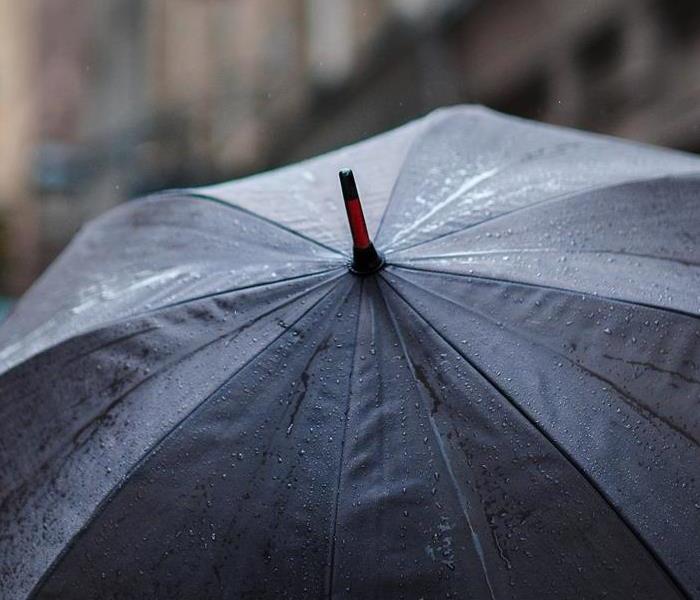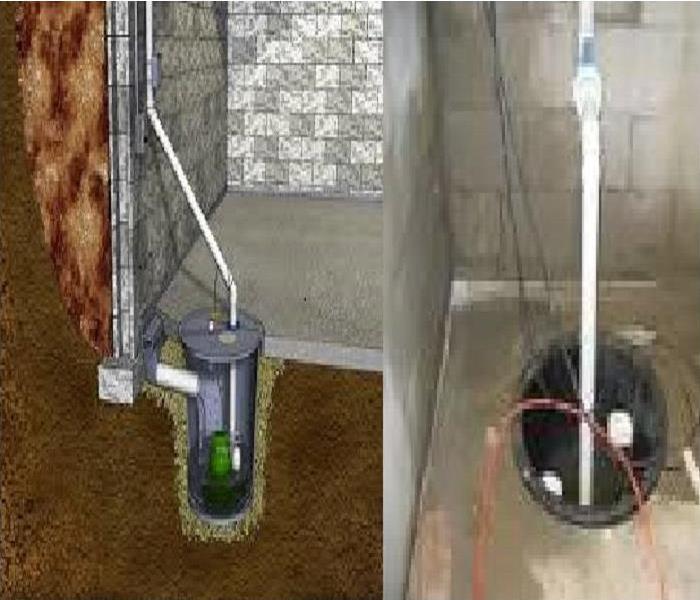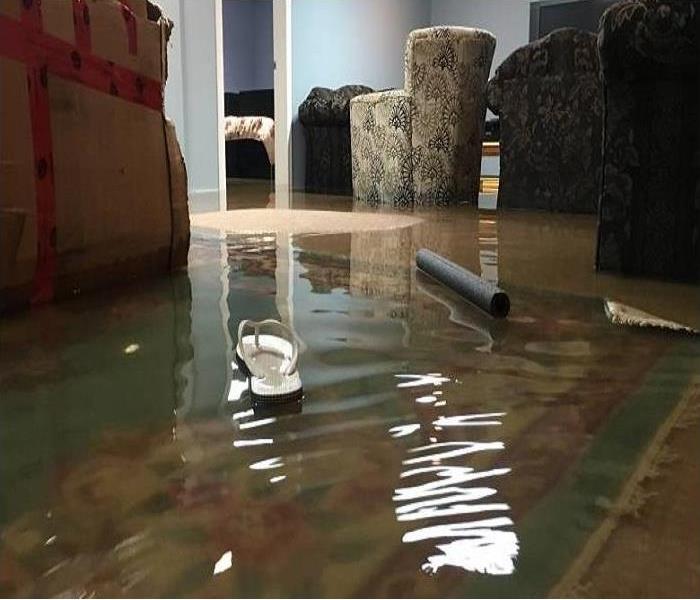Recent Water Damage Posts
What to Expect for Water Mitigation
10/8/2024 (Permalink)
Water damage can strike when you least expect it—whether from a burst pipe, severe weather, or a leaking appliance. It doesn’t take long for water to cause serious damage to your home or business. That’s where SERVPRO® comes in. Our water mitigation services are designed to stop the damage in its tracks and get your property back to normal as quickly as possible. Here’s why SERVPRO is your go-to for all things water mitigation.
What is Water Mitigation?
Water mitigation is the process of preventing further water damage after an initial leak or flood occurs. This involves removing excess water, drying the property, and securing the structure to avoid long-term issues like mold growth, structural damage, and weakened foundations. The goal is to stabilize the situation and prevent secondary damage.
Fast Response, Anytime
When water damage occurs, every second counts. The faster the water is removed and the drying process begins, the less damage your property will sustain. SERVPRO is available 24/7 and ready to respond immediately to any water emergency. We understand that a quick response can make all the difference, which is why our teams are always on standby to help.
Advanced Water Removal and Drying Equipment
At SERVPRO, we use state-of-the-art equipment to quickly and effectively remove water and moisture from your property. Our team utilizes powerful pumps and vacuums for water extraction, followed by industrial-grade dehumidifiers and air movers to speed up the drying process. This helps to minimize the chance of further damage and reduces the risk of mold growth, which can occur if moisture is not properly handled.
Handling Water Damage from Start to Finish
SERVPRO doesn’t just stop at water removal and drying—we’re with you every step of the way to ensure your property is fully restored. From the initial assessment to cleaning and repair, we handle everything so you don’t have to juggle multiple contractors. Our comprehensive services include repairing any structural damage, replacing flooring or drywall, and restoring your belongings whenever possible.
Working with Insurance
Water damage often requires an insurance claim, and navigating that process can be stressful. SERVPRO works directly with your insurance company to make sure everything is properly documented. From creating detailed estimates to providing real-time updates, we’ll help you move through the insurance process with ease, so you can focus on getting back to normal.
Highly Trained Water Damage Specialists
At SERVPRO, our water mitigation experts undergo extensive training to stay at the forefront of water damage restoration techniques. Our IICRC-certified team members bring the skills, experience, and equipment necessary to tackle any water damage situation, no matter the size.
Why SERVPRO for Water Mitigation?
SERVPRO is a trusted leader in water damage restoration with over 50 years of experience. We take pride in our fast response times, advanced technology, and dedication to restoring your property to pre-damage condition. Whether it’s a small leak or a major flood, you can count on SERVPRO to get the job done right.
Get Back to Normal with SERVPRO
When water damage strikes, SERVPRO is the name you can trust for a fast and effective recovery. Our expert team will be there to mitigate the damage and restore your property, making it “Like it never even happened.”
Always Be Looking For Water Damage At Your Home or Business
12/7/2022 (Permalink)
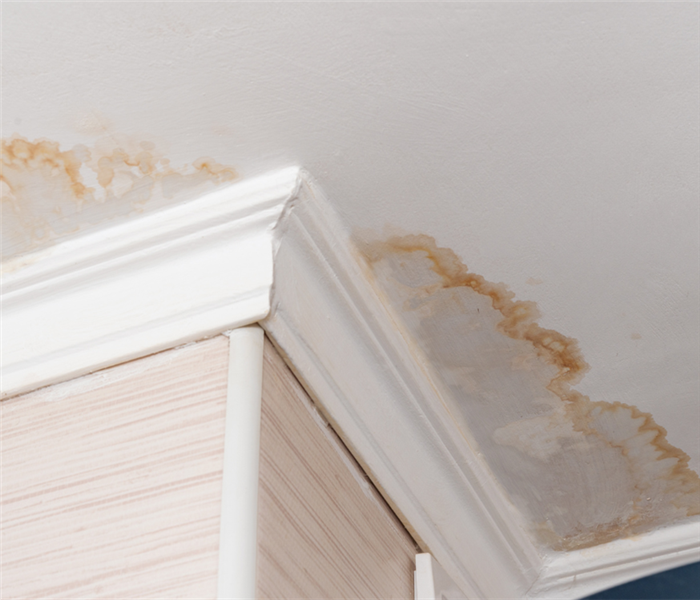 Water rings and stains on your ceilings and walls are signs of water damage!
Water rings and stains on your ceilings and walls are signs of water damage!
Water damage can be very detrimental to your home or business! Most people don’t know that the longer you wait after having water damage the more damage you are actually causing to your home or business. When you have water damage the best thing to do is shut off the water source that is causing the damage. If the damage is coming from something you are unable to cut off, you may need to contact a plumber in your area. Once this is completed then you want to call the professional experts here at SERVPRO® of The North Coast to come out immediately and assess the problem. It doesn’t matter the size of the damage we will be able to help get it under control. Water damage can be difficult to spot but here are some signs you can look for in your home and business:
- Water rings on your ceiling or walls
- Soft or sagging on your ceiling or walls
- Wet or soggy carpets
- Warping in your wood flooring
The best thing to do is call an expert right away before the problem gets worse. Our highly trained technicians are waiting for your call. We have our specialized equipment ready to use to get your disaster mitigated as soon as possible. Don’t wait until the problem gets worse, call our highly trained team at SERVPRO® of The North Coast today!
The Water You Don't See
7/15/2022 (Permalink)
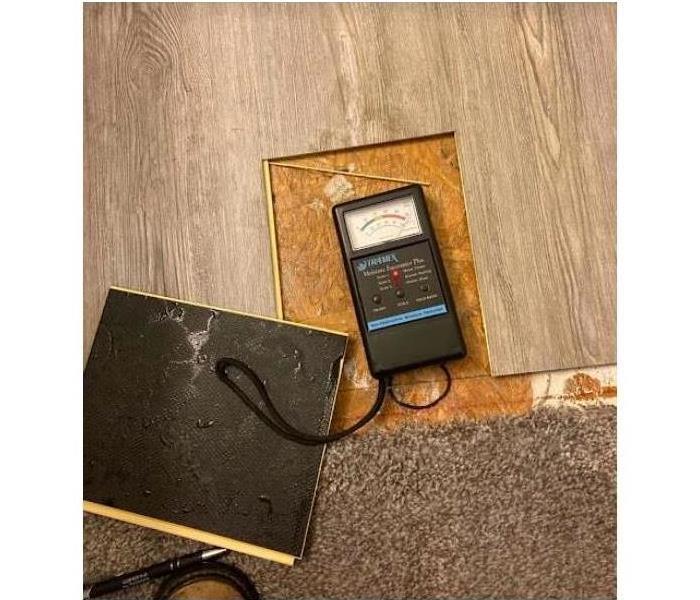 If you find water hiding in your home, call our SERVPRO Team today! Don't wait!
If you find water hiding in your home, call our SERVPRO Team today! Don't wait!
Even the smallest water damaged areas have the potential to cause serious structural and indoor air quality issues over time. The key to avoiding costly restoration in the future is to handle every water problem as a real threat to your residential home or commercial property. SERVPRO of The North Coast has the professional equipment, highly-trained staff and proven experience to detect and dry hidden water before secondary damages occur. The proper equipment makes a measurable difference in reducing the damage expense during a fire or water loss. When time matters, technology and equipment must be counted on to perform. Our SERVPRO Team will answer your call with fast action and a full arsenal of drying equipment. Here are a few of the tools used by SERVPRO to detect and find hidden moisture:
- Moisture Sensors are used to detect moisture in carpets, baseboards and walls.
- Moisture Meters are used to determine the actual moisture content of various materials. The moisture tester provides accurate readings, allowing us to monitor the drying process.
- Thermohygrometers measure temperature and relative humidity. When presented with this information, our technicians can calculate and create an environment most conducive to drying. When facing a contaminated water loss, it is not only important to dry the structure, but the structure must also be disinfected and deodorized.
- Ultra Low-Volume (ULV) Foggers will atomize liquid deodorizing agents, producing a fine mist that can easily penetrate the site where odor-causing residues may accumulate. This device can also be used to inject fungicides and disinfectants into wall cavities and other hard-to-reach areas.
- Thermal Foggers dispense solvent based products by creating a dense fog. The fog consists of tiny particles of deodorant solution that attach to and neutralize odor causing particles to deodorize structures, garments, automobiles and other places where cleaning cannot reach.
The bottom line? SERVPRO of The North Coast has the training and equipment to make it “Like it never even happened.” Call us today!
What You Should Know About Water Damage Restoration Planning
7/14/2022 (Permalink)
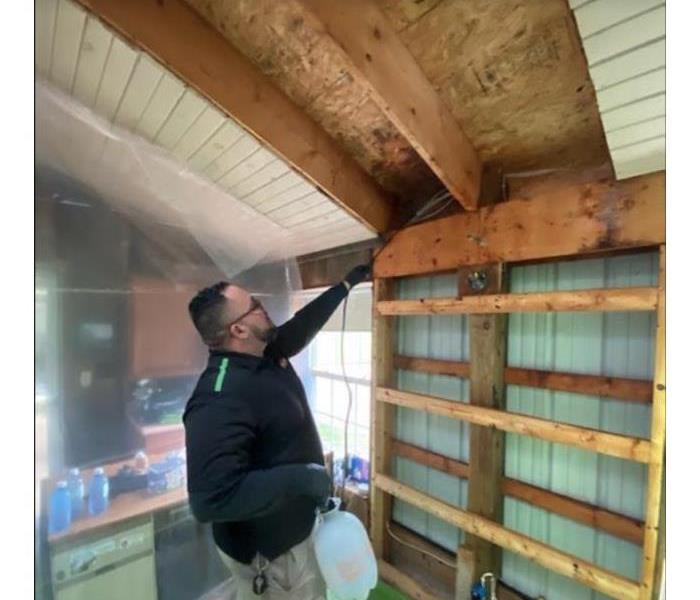 Call the trusted leaders in the restoration industry!
Call the trusted leaders in the restoration industry!
When homeowners find themselves faced with water from a flood or bursting pipes, they often want to know how long the restoration efforts will take. The answer depends on the extent of the damage, the type of water to invade the home and materials used throughout the affected area. Homeowners can expect the process to take anywhere from two to three days, but to not be surprised if it takes as many as seven. Some factors that affect the time it takes to dry out a home include:
- The type of water to flood the home
- The size of the area affected
- The building materials affected
Type of Water
Clean water is easier to clean up than black water, as the former doesn’t require special Hazmat materials or equipment. If your problems stem from bursting pipes, the solution may be as simple as fixing the pipes and drying out the area. If you do so within 24 to 48 hours, you can prevent mold and bacteria growth as well.
Size of Affected Area
The type of water isn’t the only factor to affect restoration times. The size of area plays a huge part as well. If the size of the affected area is relatively small, less than ten square feet, restoration efforts can take as little as two days, and you may even be able to perform them yourself. However, if your entire ground floor is flooded, it could take several days of professional efforts.
Materials Impacted
If it is just your carpet that is affected, restoration efforts shouldn’t require much of your time at all. However, if your drywall, insulation and/or framing are impacted, you may need to do more than fix a broken pipe. Restoration efforts in the latter instance could take as long as 10 days or more.
Every situation is different, and the water damage caused by bursting pipes could be far more severe than damage from, say, a leaking pipe. Talk to your local SERVPRO of The North Coast water damage restoration team to learn more about what to expect.
Drying Goals During Water Removal
6/6/2022 (Permalink)
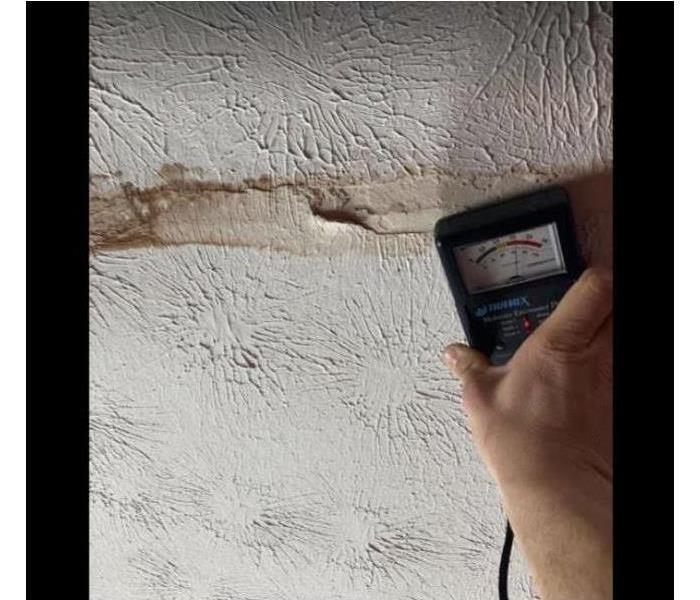 Our SERVPRO of The North Coast Team uses state of the art equipment during the water restoration process.
Our SERVPRO of The North Coast Team uses state of the art equipment during the water restoration process.
Water damage technicians create a drying goal during your home’s initial assessment. The drying goal should indicate the condition of materials and contents once restored to their natural preloss dryness. Qualified technicians should always monitor the drying process to determine if current procedures remain in-line with any established goals.
A drying goal for water removal at your Cleveland property is the intended result in affected areas after completing restoration services. Our dedicated technicians use years of experience, training, and advanced equipment to provide moisture content readings from dry, unaffected contents, and structure — readings in percentage for wood materials, and readings in points for non-wood materials.
Our SERVPRO technicians use drier air to increase the rate of evaporation while performing water removal services on your property – drier air means air with low humidity. A relative humidity (RH) of less than 40% is within the normal range for performing an effective drying solution. RH under 40% typically tells us that the air is dry and thirsty, allowing it to pull more water from wet materials within the affected area.
While measurements for RH does not guarantee that your structure is dry, reaching a low RH ensures that humidity within the affected area is decreasing. To determine whether the area is dry, SERVPRO technicians take specific humidity readings of the affected areas; these readings should match those taken in unaffected areas. We use moisture meters to measure the moisture content of wet materials found in your home.
SERVPRO water removal technicians set moisture content goals on a per-item basis – after establishing a drying standard and recording typical equilibrium moisture content (EMC). The dry standard is a moisture content reading taken from dry materials of the same type found in unaffected areas. We establish a dry standard or use a typical EMC of a material as a goal. Once the readings match, the drying process is complete.
Call our SERVPRO of The North Coast Team for water removal, cleanup, and restoration services, 24-hours a day, 7-days a week.
Is Water Damage An Emergency?
2/17/2022 (Permalink)
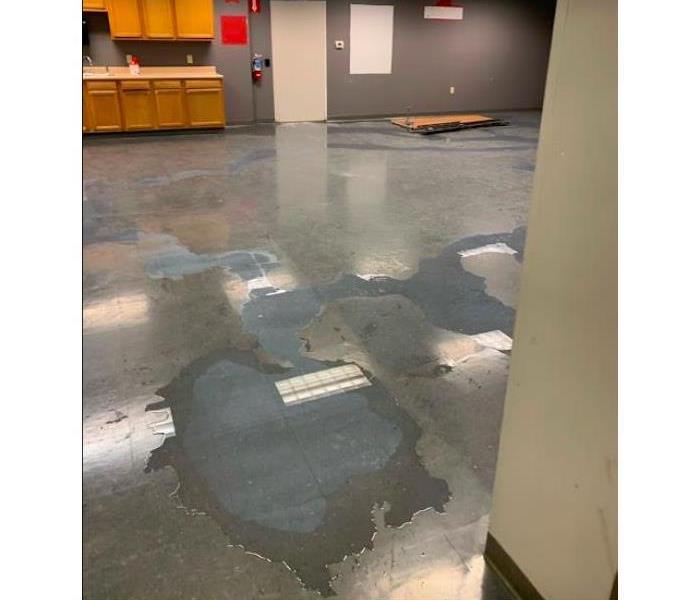 Don't let water damage ruin your commercial property!
Don't let water damage ruin your commercial property!
Having a water damage in your home or business is a very stressful situation. Many things can go through your mind, but how do you know if it is an emergency? If no one is injured, then by definition it is not considered a "true" emergency and 911 usually does not need to be called.
However, it could still be an emergency in regards to your property. The longer that water sits on the building materials, the more possibility there is that secondary damage will occur. Water can seep into wall crevices and down through the floors below. If it is not cleaned up and dried out properly, then the potential for mold growth is high.
If you walk in and see water pouring into your home or business, step 1 is to find the main water shutoff, and to shut off the water.
Also be very aware of these other things that may be affected and could be a potential hazard, such as the electricity supply, gas supply, water damaged electrical appliances, contaminated water (gasoline, chemicals, etc.) or structural damage.
So if you don't call 911, who do you call?
- Local SERVPRO of The North Coast Restoration professionals
- Insurance Agent
- Insurance Company
We work hand in hand with your insurance company to act fast, so we can get your home or business back to normal. We are available 24 hours a day to address these water emergencies. When it comes to water damage, don't take chances. Call us today and get the damage taken care of, the right way!
Why Are Dehumidifiers Important?
12/16/2021 (Permalink)
 Drying out flood damaged homes takes more than just clever tools and equipment.
Drying out flood damaged homes takes more than just clever tools and equipment.
Drying out flood damaged homes takes more than just clever tools and equipment. You need an expert restoration team, with high-level skills and knowledge of the most efficient techniques. This is what SERVPRO of The North Coast can offer you if flooding has recently hit your property. We have access to state of the art drying machines, but we also know how to maximize their power.
Dehumidifiers are one of the most important drying tools when it comes to repairing flood damage in Cleveland. It extracts the moisture from of the air and returns it to dry air. This is an essential part of the restoration process because flooding does not just leave its mark in standing water. For successful repairs, all moisture has to be eliminated, whether it is in the air, on the ground, or caught in soft furnishings.
Keep reading to learn more about how SERVPRO sets up dehumidifiers and gets the drying process started quickly.
Type Of Materials
The first thing that our SERVPRO technicians do is carry out an inspection. They enter the flood-damaged area and determine the extent of the damage. Before dehumidifiers can be set up, they first need to know what kind of materials need drying. Porous items (curtains, sofas, carpets, wood, etc.) are the hardest to restore. If a lot of porous items are wet, a longer drying period is required.
On the other hand, if wet materials are non-porous (metal, plastic), the drying period will be quicker and fewer dehumidifiers may be used. Most homes contain a mixture of the two, which means that technicians have to find a careful balance. Too many dehumidifiers can cause the air to become overly dry. This may damage softer materials like wood. Often, air movers are combined with dehumidifiers to prevent this from happening.
Putting Together A Plan
For all of these reasons, it is necessary for flood repair teams to think very carefully about how they set up drying equipment. To homeowners, it may appear arbitrary, but many precise calculations are involved. For instance, to determine how many dehumidifiers are needed and of what size, the following information must be gathered:
- Size of the flooded area (in feet)
- Type of flood damage (based on porosity)
- Type of dehumidifying technology available
- Average amount of water to be removed per day (in pints)
Choosing The Right Experts For The Job
So, you can start to see why flood damage restoration is such a complex task, even if the damage is modest. You should seek the help of a professional company like SERVPRO of The North Coast. We are a locally based service, so our technicians are perfectly placed to respond to emergencies. Call us 24/7 at (216) 221-3333.
Cleveland's Preferred 24 Hour Emergency Water Damage Service
12/1/2021 (Permalink)
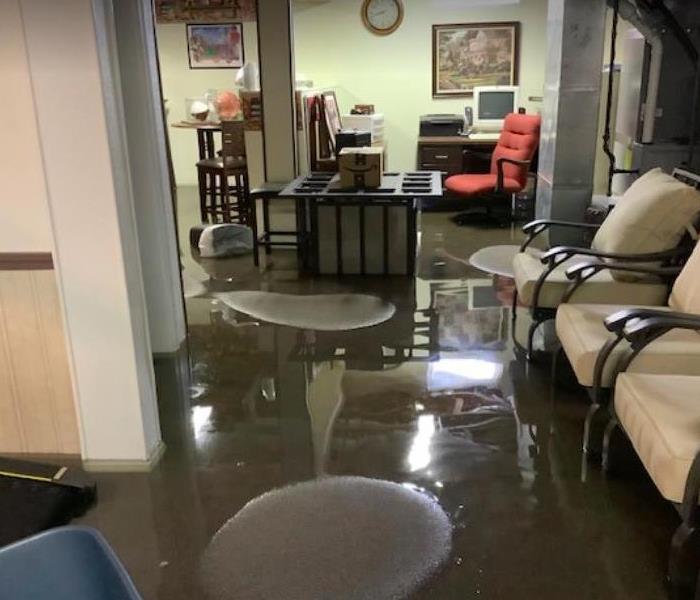 SERVPRO of The North Coast provides 24 hour fire and water damage restoration service in Cleveland.
SERVPRO of The North Coast provides 24 hour fire and water damage restoration service in Cleveland.
SERVPRO of The North Coast is available 24 hours a day for water emergencies, large or small. When you are dealing with water damage, immediate action is crucial. A delay of just a few hours can greatly increase the severity of the water damage.
We Answer the Phone Ready to Help
Call Today - (216) 221-3333
We understand that when you call us, you may be feeling confused, stressed, and vulnerable. You need an expert to guide you through this crisis. SERVPRO of The North Coast has the specific water damage training and experience to help you through this tough time. We specialize in water damage restoration—in fact, it's the cornerstone of our business.
What to Expect
When you call, we will ask several questions regarding your water damage emergency. These questions will help us determine what equipment and resources to bring, including how many trained SERVPRO Professionals may be needed.
Our SERVPRO Representative will ask several questions:
- Your name and contact information
- Your insurance information (if applicable)
- The street address of the water-damaged home or business
- When did the flooding or water damage occur?
- What caused the water damage (if known)?
- Is there electricity available (on-site)?
About SERVPRO of The North Coast
SERVPRO of The North Coast specializes in the cleanup and restoration of residential and commercial property after a fire, smoke or water damage event. Our staff is highly trained in property damage restoration. From initial and ongoing training at SERVPRO’s corporate training facility to regular IICRC-industry certification, rest assured our staff is equipped with the knowledge to restore your property.
We Have The Certification To Restore Your Water Damaged Home
7/14/2021 (Permalink)
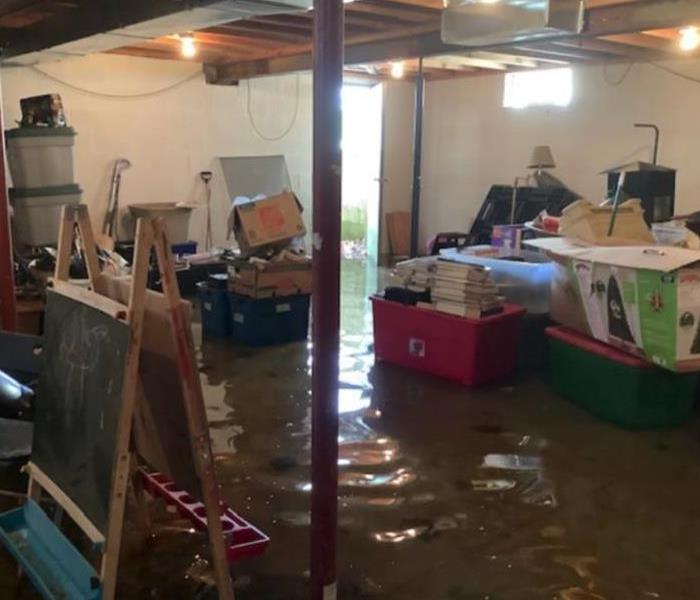 Our SERVPRO Team can handle any size of flood damage!
Our SERVPRO Team can handle any size of flood damage!
Flooding of any type will ruin some personal possessions (books, papers, and cloth) within minutes. In just a few hours, carpets and flooring can be destroyed as well as furniture. After only a day, walls can become damaged past repair and will have to be removed and replaced before a homeowner or renter can return to their house.
When it comes to water removal for our Cleveland neighbors, we require our personnel to meet the high standards established by the Institute of Inspection Cleaning and Restoration Certification (IICRC). SERVPRO also maintains an extensive inventory of specialized equipment built to extract flood water, regardless of the source and where it might be located in your home.
Each team member is trained on this equipment to quickly remove water. Since that is only the beginning, however, we also require them to become certified in five areas as determined by the IICRC. They are:
Water Damage - This overall course covers the many types of water damage and the effects it has on a home. Concentration is given to problems such as overflowing sewers and mold contamination.
Applied Structural Drying - This teaches each technician to use monitoring equipment, moisture extractors and specialized heaters and fans to dry walls and floors that have been under water.
Carpet Cleaning - Our team members learn to identify fabrics and the proper cleaning techniques required for each one. They also are taught to safely use the different cleaning chemicals available to us and how to use them with our vacuums and extractors.
Upholstery and Fabric Cleaning - Techs learn more fiber and cloth identification. Each person also learns about the specific cleaning issues needed to prevent fabrics from bleeding their colors, shrinking or otherwise becoming distorted from having been soaked.
Odor Control - Personnel learn to identify the source of odors caused by flooding or other water damage and the deodorization techniques available to combat them.
In addition to these areas, each technician is trained and qualified on every piece of equipment they might use on each job. Our inspectors also receive additional, specialized training to identify potential problems before they happen.
If you may have or suspect damage from previous flooding, call our SERVPRO of The North Coast Team today at 216-221-3333 to schedule an inspection!
First 48 Hours After a Flood
7/14/2021 (Permalink)
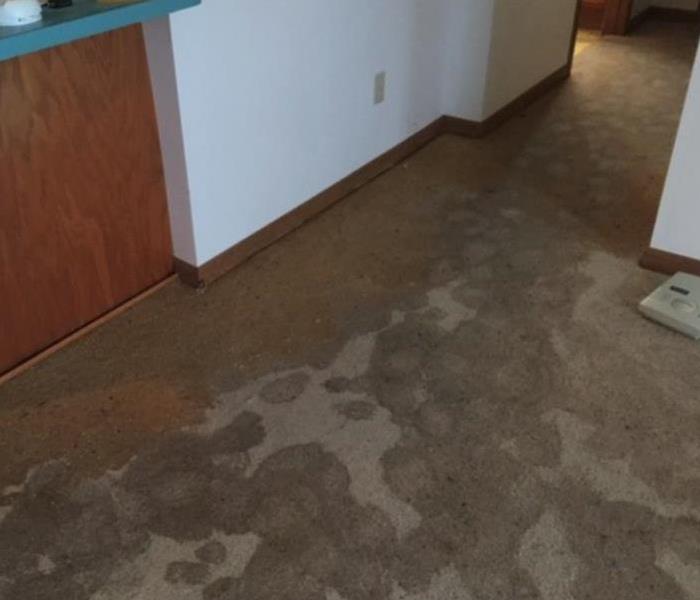 Don't wait! The first 48 hours are critical!!
Don't wait! The first 48 hours are critical!!
Act fast. The sooner you clear the contents out of your basement during a water incident, the more likely you will be able to restore the condition to your items and possessions.
When a finished basement experiences significant water damage, such as a basement flooding or a water pipe burst, timing is everything. Where the sooner you begin the disaster recovery process, the more likely you will be able to restore the condition of your possessions and the finished basement environment.
The first 48 hours are considered the most important time period to react, as it is crucial to preventing further damage to the basement and the items within, as well as preventing a wide spread mold problem. Below are the first steps to take, preferably within these first 48 hours.
- Turn Off the Power. Never enter a flooded basement or touch the flood waters without cutting off the power.
- Call your insurance company. Policies differ. Most require special flood insurance to cover ground water leaks, but homeowner’s insurance may cover damage from indoor plumbing and hot water heater leaks.
- Get the water out as soon as possible. Call SERVPRO of The North Coast to extract any standing water. If there isn’t a lot of water, you might try to get it out yourself, with a “floor sucker” or a shop-vac.
Dry everything out as quickly as possible
To prevent items and building materials from becoming ruined, dry your basement as soon as the water is removed. Ideally, the basement should be completely dry within 48 hours. After that, the potential for mold growth increases considerably. A professional restoration company might help expedite this process. Alternatively, you can consider acquiring a powerful basement dehumidifier.
EWWWW!!! What's That Smell? It Might Be Water Damage
6/22/2021 (Permalink)
 If you smell something funny in your home, don't wait! Call SERVPRO of The North Coast today!
If you smell something funny in your home, don't wait! Call SERVPRO of The North Coast today!
Do you know when to be worried about a funny smell? Most new homeowners are not water damage specialists, but the human nose is an excellent tool for sniffing out trouble. Your nose is not the only way to spot water damage in your new home. Our SERVPRO of The North Coast technicians are IICRC certified and can help handle any moisture problems you may discover after moving in.
The sooner you notice a problem, the sooner you can call our team to help mitigate ongoing damages. With summer coming in northern Ohio, some water damage will be easier to spot. When you notice a problem, a highly trained SERVPRO professional can assess the extent of your damages. We can use our specialized equipment to remedy the issue fast.
What should you keep an eye out for when you do your spring cleaning? Start at the top. When looking for roof damages, obvious water stains aren't the only problem. Swollen insulation is usually an indication of water retention. Check your flashing (where the roof meets the walls) for cracks and look for missing shingles as well as more obvious signs like holes. Look at door frames and molding. Unusual stains or dark spots on the walls can mean trouble.
Inside, make sure you check your appliances after you move in to be certain they are not leaking where you cannot see easily behind them. Cracked hoses and loose connections can be tricky. Ripples, buckling, and changes in texture can tell you the flooring has a water problem. Remember to trust your nose. If it smells wrong, it probably is.
Outside water damages and mold are often caused by improper drainage. Check your spouts to see that they are clear and make sure you do not have water pooling around the foundation of your new home. At the first sign of damage, you can call SERVPRO.
No one wants to find water damages in their new home this spring. If you do, SERVPRO of The North Coast is available at (216) 221-3333 24 hours a day. We can make things “Like it never even happened.”
Ahh! My Pipes Are Frozen!!
2/23/2021 (Permalink)
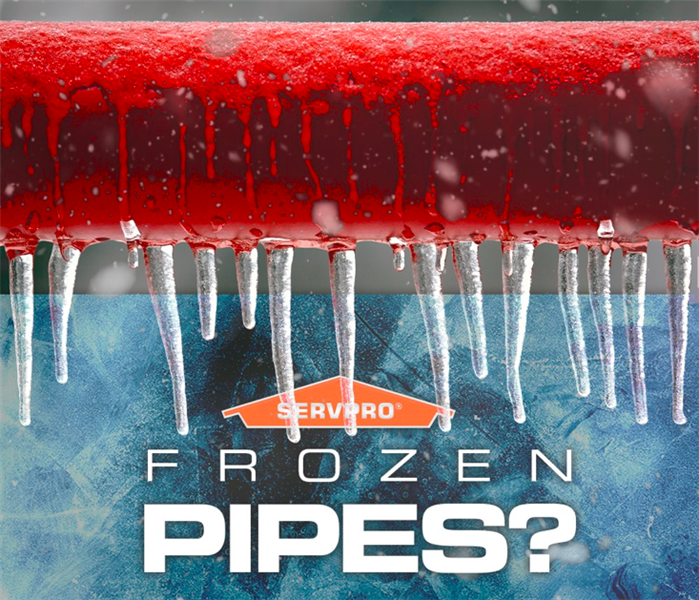 Cold temperatures can lead to frozen pipes, that's why our SERVPRO Team is always here to help!
Cold temperatures can lead to frozen pipes, that's why our SERVPRO Team is always here to help!
The cold temperatures in Cleveland can lead to a number of problems for local homeowners. One of which may include frozen pipes. A hard freeze can even lead to broken pipes or water damage in your home. Here are some things you may want to know about what to expect when your pipes freeze.
What To Do When Pipes Freeze
If you have a frozen pipe in your home there are a few things you can do
- Call a professional, like SERVPRO for help
- Keep your pipes open so the water has a place to go when thawed
- Apply gentle heat, like a hot towel or blow dryer, to the frozen area of the pipe
Why Pipes Freeze
During a hard freeze the temperature outdoors can drop so low that the cold can permeate the pipes. Any water inside will then expand. If there is not enough room inside the pipes, then the pressure can cause cracks which will lead to leaks when the water thaws. A water damage professional can help with repairs to your home if the leak causes damage.
Preventing Frozen Pipes
Fortunately, there are a few prevention steps you can take to prevent the freezing of your pipes and subsequent water damage. These steps include draining the water from pipes that may freeze such as a sprinkler line, and disconnecting any hoses from your home. You may also want to close any indoor valves that supply water to outdoor lines. If the weather is especially cold you may want to let your faucets drip a little as moving water is less likely to freeze. It’s also a good idea to keep your home’s temperature above 55 degrees.
When a hard freeze occurs, the water in your pipes can freeze and cause some damage to your home. A professional can help with any repairs and cleanup you may need. If you know that the temperature is likely to get to freezing point, you may be able to take some steps to protect your pipes.
Restoring Your Wooden Furniture
12/8/2020 (Permalink)
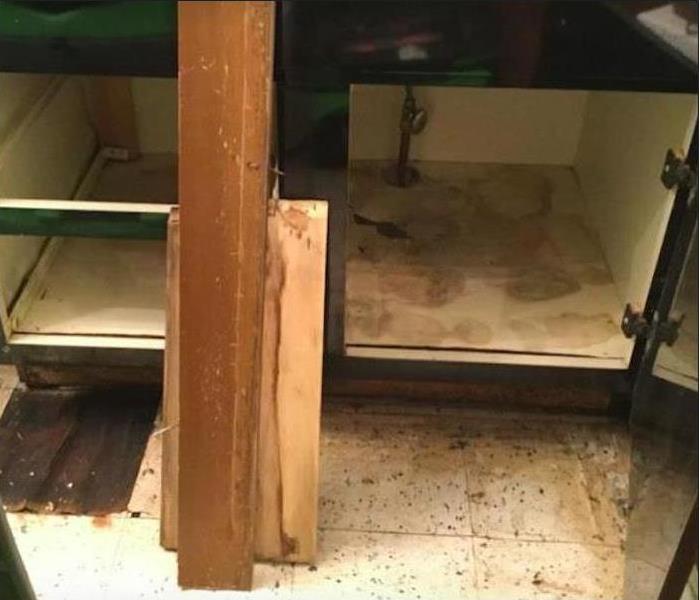 Water damage can cause significant damage to your wooden furniture and cabinets.
Water damage can cause significant damage to your wooden furniture and cabinets.
Water damage can strike any household at any time. There are various causes of water damage, including a burst pipe, an overflowing tub, a leak or a broken appliance. Water can also enter your home from outside sources such as a damaged water main, garden run-off or severe weather. When water leaks or soaks in, it has the potential to cause untold damage to your home and belongings. That is why it is important to contact SERVPRO for help when dealing with unwanted water in your home - “We’re faster to any size disaster.”
There is no doubt that wooden furniture can suffer if there is water damage to your Cleveland home. That is bad news for your antique rocker, favorite family dining table or that wooden chest of drawers you inherited from your beloved aunt. The main cause for concern when it comes to wooden furniture is that water can cause it to warp. Wicking up water can also cause swelling of furniture joints and cause them to come unstuck or suffer other structural damage. There is also the risk of water spots or stains on the surface of the item. Chairs, tables, and other items may also crack or warp as they dry.
Our IICRC-experts are experienced in creating the optimum drying conditions for wood furniture. While you are waiting for the specialists to arrive, it is safe to use an absorbent cloth or sponge to pat furniture dry. However, we recommend that you do not wipe or rub it and that you handle it with extreme caution.
SERVPRO experts are trained to assess the damage to your furniture and liaise with furniture refinishers on your behalf if necessary. If it is possible to save the item we set up a drying area for it. The key to getting a great result when drying wood furniture is to dry it slowly and avoid direct heat. We also have wood cleaning products for the removal of minor stains.
Our technicians are equipped with air movers, box fans, and dehumidifiers to help dry out your items. Once we get the temperature to a stable 70-90 degrees F, we use portable low grain dehumidifiers to bring down the humidity around your furniture. Meanwhile, air movers direct air around, over and under the item to increase the rate of evaporation and encourage the drying process.
Do not let water permanently warp your furniture. Call SERVPRO of The North Coast at (216) 221-3333 today for drying solutions.
Restoring Your Carpets After A Flood
11/25/2020 (Permalink)
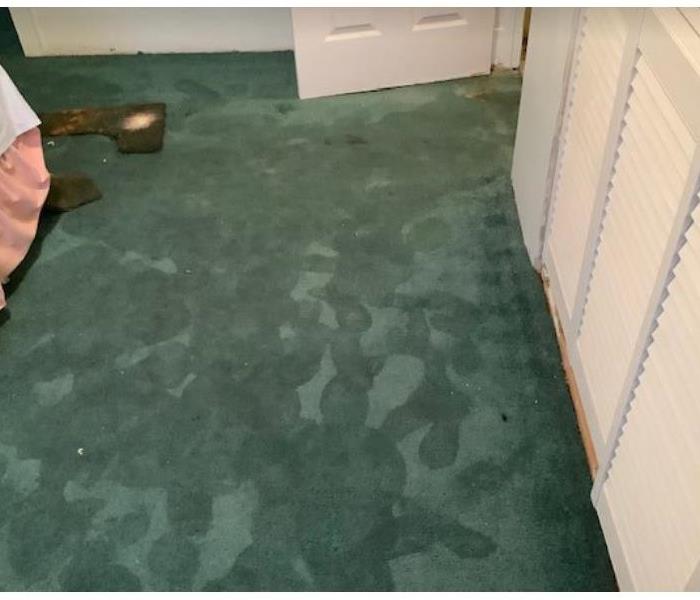 In some situations, only padding under a carpet needs replacing after incurring water damage.
In some situations, only padding under a carpet needs replacing after incurring water damage.
Carpet replacement can be one of the costliest parts of a water damage cleanup process, but it does not always have to happen. While carpet can easily be damaged beyond possible repair, in many cases SERVPRO can restore your carpet without needing to replace part or all of it. The most important and deciding factor is the severity and type of water damage in your Columbus home - storm flooding and some other forms of damage are typically irredeemable. If the flooding is benign, or if the damage is light overall, we can help save your carpet (and your wallet).
Rapid Drying
Our primary method of softening the impact of water damage in Cleveland is our time-tested strategy of mitigation. If the carpet is allowed to stay damp for too long, damage can become permanent, and mold can begin to grow. Within four hours of your first call to us, our personnel should be on-scene to evaluate and respond to damage.
Floodwaters can be extracted before they have time to settle in and cause more severe damage, and we can quickly set up powerful air movers to create powerful, water-removing air currents in your home. Finally, we then use dehumidifiers to take water back out of the air, leaving any scene of water damage completely dry within a short time frame.
Restorative Techniques
Once the carpet has been dried, it likely still needs some restorative processes to be back in top shape. SERVPRO specializes in this, with dedicated cleaning tools and techniques to help maintain color, texture, and integrity of carpeting. During this time, if we determine that a region of carpet is more seriously damaged or otherwise needs replacing, we can typically cut off that spot alone for replacement without removing the rest of the carpet.
SERVPRO of The North Coast is available around the clock to respond to water damage emergencies in the local area. If water damage has hit your home or if you would like to learn more about our services, call us at (216) 221-3333.
Water Damage Experts Here For You!
7/15/2020 (Permalink)
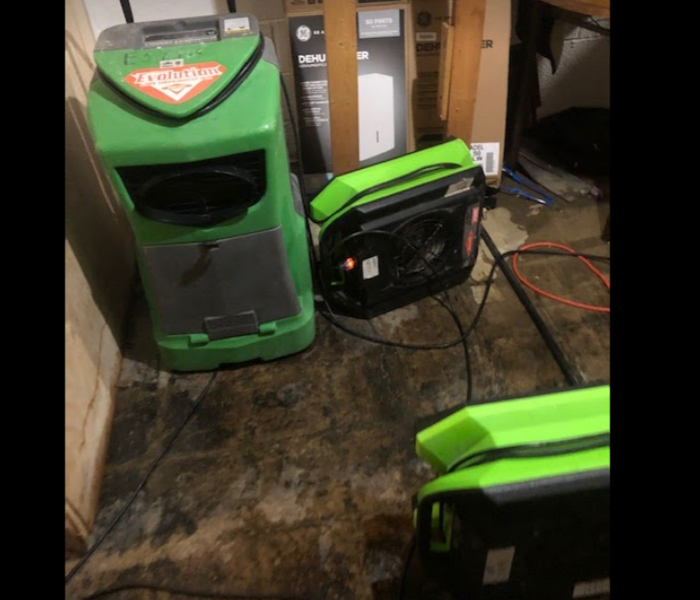 Our SERVPRO Team uses state of the art equipment to dry out water damage.
Our SERVPRO Team uses state of the art equipment to dry out water damage.
Professional water removal services are readily available to you through our professional residential and commercial restoration processes. Don't leave anything to chance, see how our expert technicians and advanced equipment made us a responsible trusted leader within the industry!
We have a highly efficient water removal team in Cleveland that is eagerly waiting for your call! We'll work with you through everything and look forward to the opportunity to show you that our services are the best you'll find to assist you with your water removal needs! We'll help manage any paperwork involved in your case and walk you through the entire process.
Our SERVPRO Technicians are expertly trained to handle your water damage situation! Each Technician is certified to perform various functions required during different phases of our restoration process, and they desire to perform their assigned tasks as efficiently as possible to produce high-quality results for our customers.
The extraction equipment that our SERVPRO Technicians use is second to none; we spare no expense in providing our Technicians with the highest quality tools available. These extractors come in both portable and truck mounted variations, no job is too big or too small. While, submersible pumps are used to extract water exceeding two inches deep to help speed up the process.
Each extractor is made up of three main parts; a heater, a pump, and a vacuum system and their only purpose are to work together to perform a single function. They remove water!
Dehumidifiers are used throughout the process to assist in the drying process. These dehumidifiers are used to cycle the air in the surrounding area, run it through a cold evaporator coil. Inside of the evaporator coil, moisture is separated and captured in a collection tray; then warm, dry air gets pumped out of the dehumidifiers exhaust fan.
A Refrigerant or LGR Dehumidifier is used at the beginning of the process when the humidity is at its highest, while Desiccant Dehumidifiers only serve a purpose when structural materials are wet, but everything else is dry.
SERVPRO Technicians using this type of equipment ensure that we can perform our absolute best and provide our customers a level of service that is as fast, effective and efficient as possible!
Find your way to SERVPRO of The North Coast for any water removal services. Our fast, 24-Hour services at your disposal seven days a week, including all holidays!
Hidden Leaks Can Result In Costly Damages
7/15/2020 (Permalink)
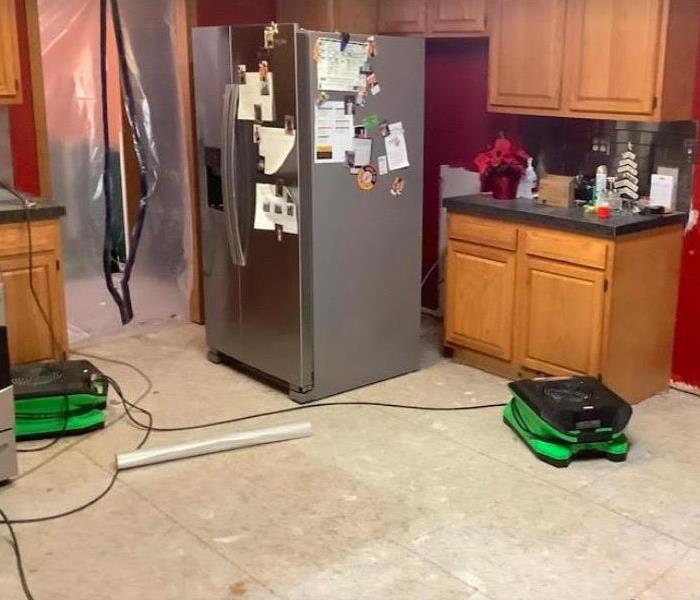 Water damage in this home was caused by an unknown refrigerator leak.
Water damage in this home was caused by an unknown refrigerator leak.
Think back, when's the last time you checked your appliances? You probably can't remember. Unfortunately appliances don't operate like vehicles do. There are no lights that come on to indicate you have a problem. Not knowing if your appliances are actually working properly can cause problems. Appliances that utilize water and are connected to a supply source are prone to leaks, breaks and cracks. Water damage caused by appliances can go unnoticed for weeks, months, and even years before a homeowner notices a problem. And unfortunately at that point, it is too late. That water that has escaped from the appliances have made its way into the walls, floors and baseboards.
Regular inspections of appliances is critical to prevent your home from experiencing costly water damage. Let's take a look at which appliances you should inspect.
- Refrigerator
- We rarely move our refrigerators because they are heavy and it's a hassle. The water supply lines that are connected to the back of our refrigerators are made up thin plastic that can break pretty easily. Check for leaks behind and beneath your refrigerator to ensure there are no hidden issues.
- Dishwasher
- A dishwasher's supply line is just as prone to leaks and breaks as the refrigerator lines are. But the supply line to the dishwasher supply a larger amount of water and are very hidden. Checking the supply line regularly could save you from costly repairs in the future.
- Hot Water Heater
- This forgotten appliance is usually hidden down in the basement closet or in a garage. Hot water heaters hold anywhere from 20 to over 80 gallons of water at a time, and last anywhere from 10 to 15 years. That's a lot of water that you don't want in your home. The seals and pipes on these are certainly susceptible to failure and should be checked for accumulations of moisture.
- Washing Machine
- The supply drain and hose are flimsy and are attached with simple hardware that can easily come loose, crack or disintegrate. Make sure to check the connection and the overall condition of these hoses monthly and replace them every couple of years.
- Air Conditioner
- Every A/C unit should have a drain as well as a safety switch that causes the unit to shutoff when excess moisture pools in the drain pan. If this drain were to malfunction, you’re going to see water appear in places you wish it hadn’t. Each unit and manufacturer are different so we recommend referring to the manual for service and inspection scheduling. A professional HVAC Technician will know what to look for and how it can be repaired.
You Notice A Water Stain On Your Ceiling, Now What?
6/23/2020 (Permalink)
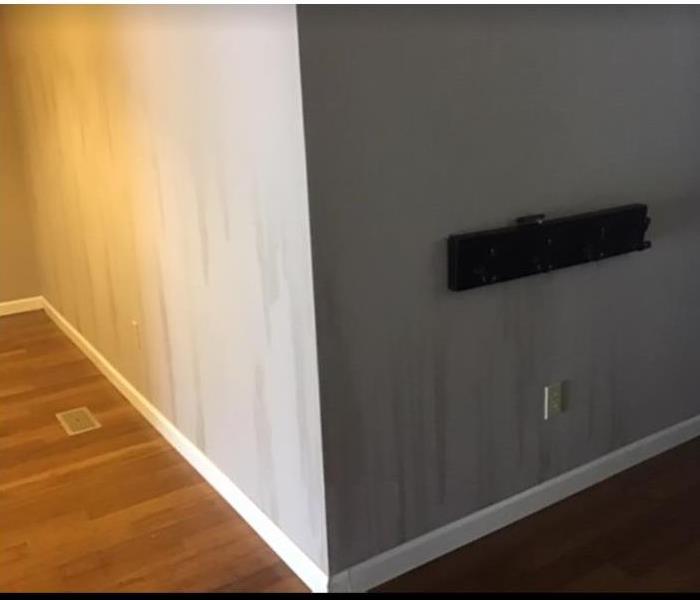 Leaking pipes caused water damage on these residential walls.
Leaking pipes caused water damage on these residential walls.
Water can be very sneaky and can hide in very unknown places. Unless there is a sudden burst or flooding in a certain area of your home, you may not notice you have a problem until the problem has been going on for a long long time.
You may think your home is in perfect condition. And then, suddenly you notice a water spot that you hadn't noticed before. Now you have a problem! You think "What do I do? Who do I call?". You call SERVPRO!
Yes SERVPRO handles the big water disasters but we can also take care of the small unknown water problems that you didn't know you had. Depending on what floor the water stain is on, we can detect where the water is coming from, whether it is coming from a leaky pipe from the upstairs bathtub or a leak in your roof causing rain to find its way into your home. Don't worry about having to call a roofer, we can take care of all of your roofing needs.
Here at SERVPRO of The North Coast we are a one stop shop for all of your water restoration needs. We can repair your roof and ceiling, replace a shower or bathtub and remodel any room in your home.
Our SERVPRO of The North Coast team is always here to help you. We are able 24 hours a day, 7 days a week. Even if you think your small water stain isn't an emergency, we will be out right away to access the damage. Call us today!
How To Know If Your Walls Have Water Damage
2/27/2020 (Permalink)
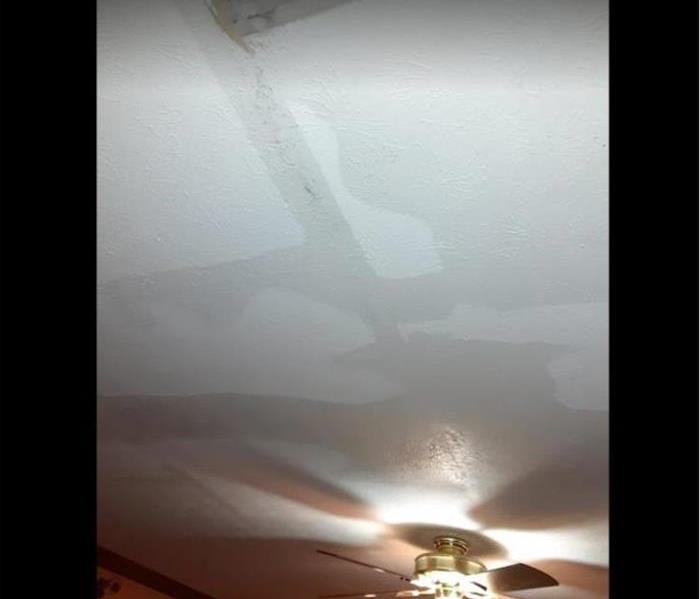 These homeowners knew they had water damage when they noticed the water stains.
These homeowners knew they had water damage when they noticed the water stains.
Have you ever wondered if your walls have water damage? Sometimes it's not so easy to identify. And, as you know, water losses don't typically happen during convenient hours of the day. It’s not always easy to identify if your walls are damaged, but here are some signs to look for.
Common Signs of Water Damage In Your Walls
- Musty Odor: Water damage can often cause mold damage and/or mildew damage if left undetected. But unfortunately, mold isn't always visible. If you notice a musty odor, that's a sign there may be mold somewhere you don't see. You want to make sure both sides of your walls are checked and tested for mold damage. Most importantly, you'll want to find the source of your water issues so the mold doesn't return and cause more damage.
- Visible Mold Growth On Walls And Baseboards: Always be on the lookout for visible mold growth, it comes in various sizes. Mold infestation can quickly spread throughout a home in 48-72 hours. But you want to be careful because mold may cause harm to you and your family's health, including your pet's. That is why it is very important to contact trained professionals who have the proper training and experience to remove and remediate mold.
- Discoloration: Discoloration is a key indicator that your walls are damaged as a result of water damage. The common colors associated with discoloration are yellow, brown, or copper.
- Peeling Or Bubbling Paint And Wallpaper: The peeling or bubbling of paint or wallpaper is another key indicator that your walls are damaged. It is important to contact trained professionals to access your walls, to prevent further damage from happening down the road.
- Warped Walls: Inspect your walls carefully to see if you have any warped walls. When the sheetrock behind a wall absorbs too much water, it will start to bend and curve, which, in turn, can cause the wall to warp.
- Water Stains: Inspect your walls carefully for any potential water stains. Water stains can easily be missed, especially if they are tiny in size. Since they can start out small, homeowners typically don't notice the water stains until they have increased in size, which, at that time, further damage may have occurred. It's a good idea to inspect around your windows and frames as well.
If you notice signs of water damage in your walls, don't hesitate to call our SERVPRO team! We are always here to help!
Causes And Signs Of Water Damage
12/4/2019 (Permalink)
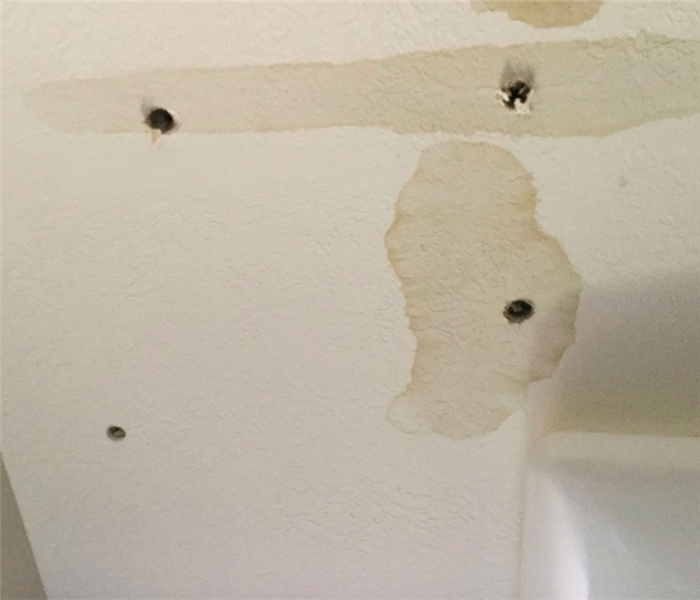 These homeowners knew they had water damage from the brown water spots on their ceiling.
These homeowners knew they had water damage from the brown water spots on their ceiling.
SERVPRO of North Coast knows that when you experience unexpected water damage it can be costly and set you back. It can occur at any time. Here are some examples of situations that can cause water damage in a home:
- Problems with the HVAC system.
- Cracks in the foundation or walls.
- Severe storms, floods and other extreme weather.
- Leaky or busted pipes.
- Malfunctioning dishwashers or washing machines.
- Roof damage, such as missing shingles or cracked flashing.
- Leaks from toilets, sinks, and showers.
- Drainage problems on your property.
Water damage is recognizable when it’s caused by a flood, but with other causes, it is sometimes hard to spot. If you are unsure of what to look for, it can be easy to miss until it becomes a major problem. Here are the usual signs of water damage in a home:
- Paint peeling from your walls
- Mold growth (which can look like dark discoloration) on any surface
- Warping of your floors.
- A strong musty smell.
- Sagging in parts of your walls or ceiling.
- Stains or discolored patches on walls or ceilings.
- Water pooling in your yard after a storm.
Our Team Responds To Water Damage Day Or Night
11/27/2019 (Permalink)
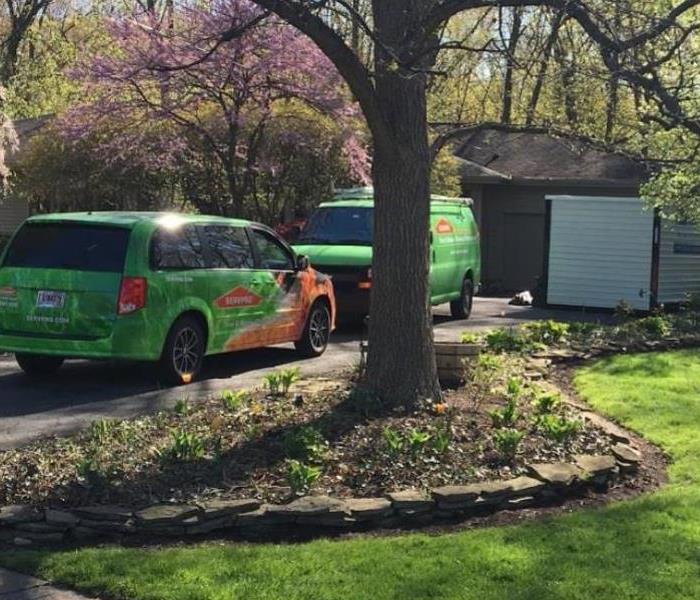 Our SERVPRO of North Coast team responding to a residential water loss.
Our SERVPRO of North Coast team responding to a residential water loss.
Flooding and water emergencies don’t wait for regular business hours and neither do we. SERVPRO of North Coast provides emergency cleaning and restoration services 24 hours a day, 7 days a week. Flooding and water damage is very invasive. Water quickly spreads throughout your home and gets absorbed into floors, walls, furniture, and more. Our highly trained professionals arrive quickly and start the water extraction process almost immediately. This immediate response helps to minimize the damage and the cleaning and restoration costs.
Water Damage Timeline
Within Minutes
- Water quickly spreads throughout your property, saturating everything in its path.
- Water is absorbed into walls, floors, upholstery, and belongings.
- Furniture finishes may bleed, causing permanent staining on carpets.
- Photographs, books, and other paper goods start to swell and warp.
Hours 1 - 24:
- Drywall begins to swell and break down.
- Metal surfaces begin to tarnish.
- Furniture begins to swell and crack.
- Dyes and inks from cloth and paper goods spread and stain.
- A musty odor appears.
48 Hours to 1 Week:
- Mold and mildew may grow and spread.
- Doors, windows, and studs swell and warp.
- Metal begins to rust and corrode.
- Furniture warps and shows signs of mold.
- Paint begins to blister.
- Wood flooring swells and warps.
- Serious bio hazard contamination is possible.
More Than 1 Week:
- Restoration time and cost increase dramatically; replacing contaminated materials and structural rebuilding may be extensive.
- Structural safety, mold growth, and bio hazard contaminants pose serious risks to occupants.
If you need emergency services, please don't hesitate to call us at (216) 221-3333
Summer Storms can Bring Flash Flooding
7/10/2019 (Permalink)
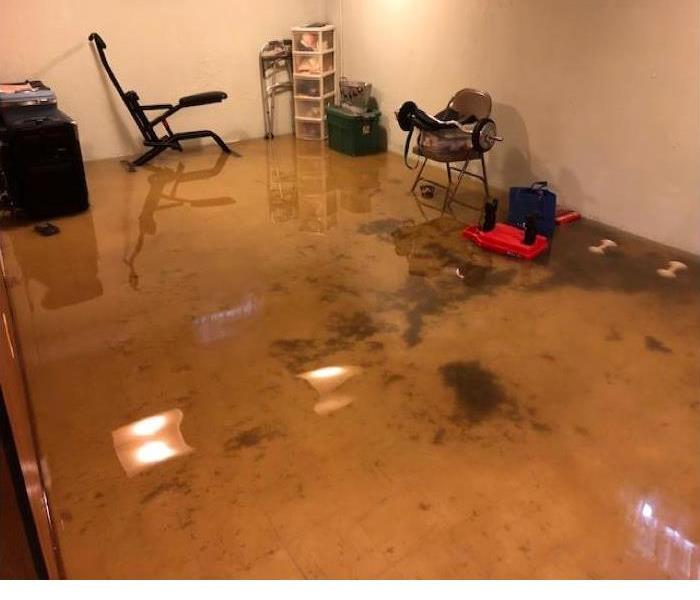 Call SERVPRO of North Coast if you experience flooding in your home or business.
Call SERVPRO of North Coast if you experience flooding in your home or business.
When we think of summer our thoughts go to sunshine, beaches and lemonade but summer storms can bring heavy rains and flash flooding. These storms can bring several inches or feet of water in a short period of time causing flooding and many dangers. The NSSC (National Sever Storms Laboratory) says that, “floods are the most common and widespread of all weather-related natural disasters and in the U.S., floods kill more people each year than tornadoes, hurricanes and lighting.”
To keep your family safe during a flash flood, follow these guidelines:
- If you live in a flood zone, have a family plan.
- Always be alert of flash flood watches and if it turns into a warning get to high ground immediately.
- Never drive into high water, your vehicle can be carried away or flip over.
- Do not walk into highwaters, only six inches of rushing water can knock you over. Flooding water is also considered sewage because the contaminates it contains.
- Downed power lines can cause the water to be deadly.
When the water recedes, there are some precautions you can take:
- Make sure is it safe to return to the flood zone.
- Check your basement for water damage caused by the flood. Do not enter if there is standing water.
- Inspect structure for damage and any risk of collapsing.
- Check for fire hazards, gas leaks and water damaged electrical circuits.
- Look for cracks or damage to your foundation.
- Ventilate your home by opening windows and doors.
- Dispose of any food that was in the flood.
- Be caution of any animals that may have entered your home.
If your home is damaged by flooding, you will need a professional water damage restoration company to restore your home. Call SERVPRO of the North Coast at 216-221-3333.
Storm Damage in Northeast Ohio
7/10/2019 (Permalink)
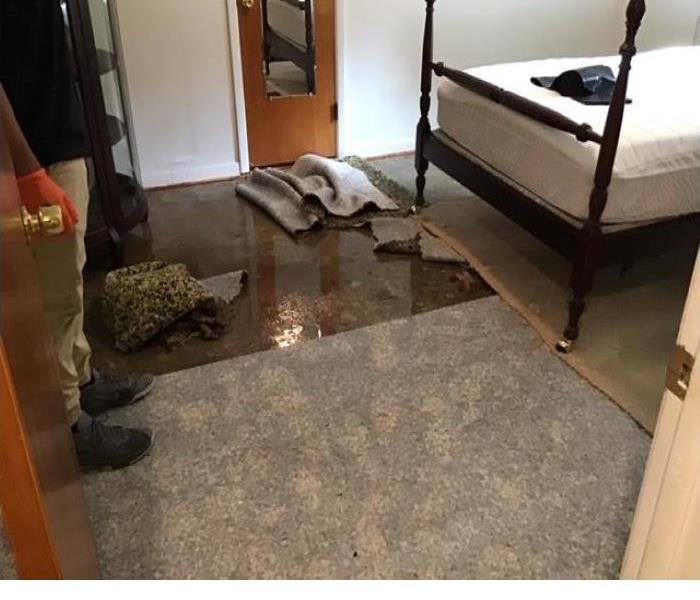 This basement flooded due to a sump pump failure.
This basement flooded due to a sump pump failure.
We received numerous calls over the past few weeks due to the flooding that has hit the Northeast Ohio. A lot of these homes flooded due to sump pump malfunctions. It is very important for Sump Pump's to be well maintained so that your basement does not get affected when heavy storms roll through the area. The following are 4 Tips for Sump Pump Maintenance:
- Test it regularly: You can test your sump pump to confirm it’s working properly. Pour a bucket of water into the sump pit. When you do this, the pump should turn on right away. Remove the water from the pit, then shut it off in a couple of seconds. Be sure that the float switch and the check valve can move freely and that nothing is in the way. In addition, check the discharge line to be sure it is not obstructed or frozen. Also, if the inlet screen is clogged, clear it of any residue or debris.
- Change Batteries: If your sump pump is backed up by batteries, be sure that the batteries are replaced every two to three years, or as directed from the manufacturer.
- Clean It: At least once a year, you should take out the pump. Begin by disconnecting it from the power. Flush it out well with water to remove any standing debris. While it’s out, remove stones, mud, debris, or anything else that is inside the sump pit. Then put the sump pump back in and reconnect it to the power. Test the unit by pouring a bucket of water into it to ensure the sump pump still functions properly.
- Be Sure the Outside of your Home is Well-Maintained: Basement flooding can be incredibly damaging. To avoid this, seal any cracks in your walls, windows, or in the foundation. In addition, clean gutters and downspouts regularly so things can drain properly. Also, make sure that the grading around your home is designed properly. It should slope away from the foundation so water can be washed away. Water buildup can happen quickly. If your home’s exterior isn’t being taken care of, you could see damage in your basement right away. A sump pump works well in normal conditions, but it can’t overcome a faulty design.
Source: https://meticulousplumbing.com/4-tips-sump-pump-maintenance/
In the even that your basement does end up flooding, contact SERVPRO of the North Coast to make it "Like it never even happened."
What to do till help arrives.
6/11/2019 (Permalink)
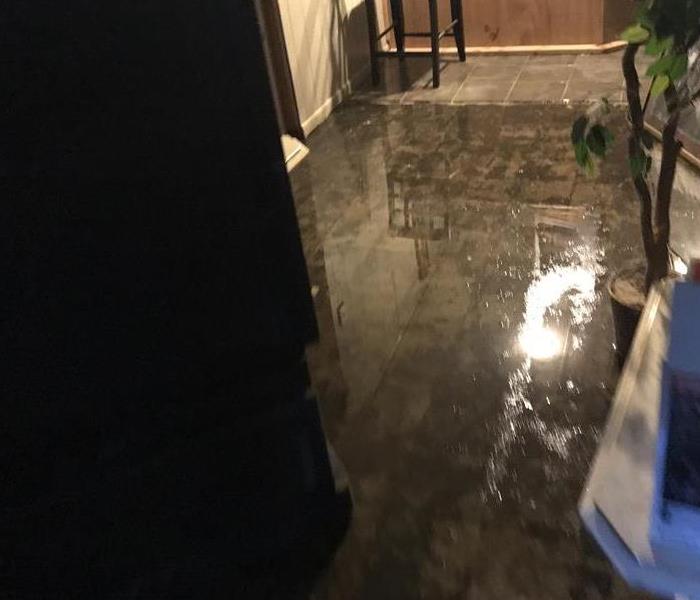 Basement flood in North Olmsted
Basement flood in North Olmsted
Should you have the unfortunate experience a water damage, safety should be your number one priority. There are many safety issues you need to be aware of to protect your family. Two of the most common safety issues are “slips and falls” and electrical hazards, however, there are others.
Water Supply
- If possible, turn off the water supply to minimize the water damage and safety concerns. Take caution when entering all rooms with wet flooring to prevent injuries from “slips and falls.”
Electricity
- To prevent being shocked or electrocuted, do not enter a room with deep standing water that may be exposed to electricity.
- If the water is high enough to reach the electrical outlets, have an electrician inspect your wiring to prevent electrical shock.
- Have electrical appliances such as furnaces, freezer, washer and dryers dried and serviced by a qualified repairman if the water has reached their electrical unit.
Gas
- If you smell gas, turn off main valve and leave the area. Call the gas company immediately.
- Have gas appliances inspected by a qualified repairman if high water has reached their gas controls.
Structure Stability
- Water damage on a second floor can compromise the ceiling below. If you see sagging ceilings do not enter the room.
Sewer Damage
- Sewer backups can present diseases and bacteria and should never be cleaned without personal protective equipment.
If you have a water damage call SERVPRO of The North Coast at 216-221-3333 to assist.
Prevent Spring Water Damage with These Tips from SERVPRO of The North Coast
3/11/2019 (Permalink)
Spring is just two short weeks away. After a cold, long winter, we’re all excited for spring and the sunny days of summer in Northeast Ohio.
However, warm weather does bring April Showers. There are a few thing we can do to avail the potential of water damage. Taking time to check the following maintenance areas you will lessen your chance of water damage to your home.
- Cleaning your gutters and making sure they are in good repair goes a long way in preventing water intrusion in your home.
- Each spring, SERVPRO receives many calls about water damage caused by outdoor spigots that are turned on. If you turn them off and drain the water supply to your outdoor spigots in the winter, you can have a damaged pipe due to the heavy freeze. When you turn your spigot on, make sure there are no leaks. If there are leaks, turn off the spigot immediately before any damage occurs and have your pipe repaired.
- Spring is a good time to inspect your roof. Ice damming is common in the winter months and can damage your shingles, flashing, eves, and overhangs.
- Check that your landscaping slopes away from your home. If it slopes towards your home, so will the water from the spring storms.
- Outdoor drains can get clogged with debris and leaves, so make sure they are free of debris and draining properly.
- Your sump pump will work over time, so make sure it’s working properly. If it’s old, this would be a good time to replace it before it fails.
Enjoy the warm weather. If you do experience an unexpected water damage, call SERVPRO of The North Coast at 216-221-3333. We are here to help!
Ottawa County, June 2018
6/13/2018 (Permalink)
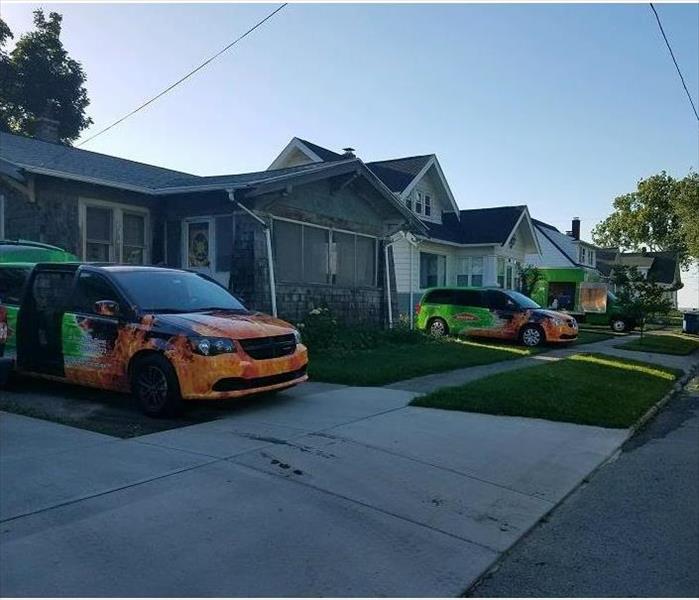 Here to help when we are needed!!
Here to help when we are needed!!
SERVPRO franchises do not worry only of their own territories, but also those that are near and far. SERVPRO of the North Coast (as do other SERVPRO franchises) responds to help our fellow franchises when the need arises. Ottawa County, Ohio was hit with heavy rains that started in the evening of 6/12/18 and ended in the early hours of 6/13/18. Up to 6” of rain fell in various areas during this time. No matter how much a homeowner may prepare their basement and/or take the necessary precautions in preventing water damage, when Mother Nature calls, there is no control over what may or may not happen. We answered the call and were there to help. Along with continuing to service our current projects we rallied to help our neighbor franchise in assisting as many homeowners as possible in the cleanup and dry out of their basements as quickly as possible. Weather events happen and along with those events come home and business damage. SERVPRO of the North Coast is here to help. Call us 24 hours a day @ 216-221-3333 and let us help you in whatever manner possible.
Sump Pump Maintenance
5/29/2018 (Permalink)
First, let’s answer the question what is a sump pump? A sump pump is a small pump that is installed to help keep the area underneath a building dry and to prevent it from flooding. They are installed in the lowest part of the basement or a crawl space. They are normally installed in specially constructed pits which is where water flows into through drains or through migration through soil. The pump’s job is to pump the water out of the pit and away from the building.
Here are some tips to help with the maintenance of your sump pump so as to prevent water intrusion in your home:
- Make sure the pump is plugged into a GFCI outlet
- Make sure the cord in in good shape
- Check the pump occasionally to ensure it is running and the breaker has not tripped
- Ensure the pump is standing upright in it’s crock
- Periodically pour a bucket of water in the pit to make sure the pump starts automatically
- Remove the pump from the pit and clean the grate on the bottom
- Check the outlet pipes to ensure they are tightly joined together and are draining at least 20ft from the foundation
- Ensure the vent hole in the discharge pipe is clear
- Install a backup battery in case of power failure
Should you still get water in your basement from sump pump failure or inability of sump pump to keep up due to the amount of water coming in, call SERVPRO of the North Coast and we can help with the clean up. We will address your structure as well as any affected contents and set the proper drying equipment to ensure your basement is thoroughly dried out. We can be reached 24/7 @ 216-221-3333.
Steps to take when your basement floods
5/18/2018 (Permalink)
Even if you’ve taken steps to protect your basement from water damage, a burst pipe, broken sump pump, or heavy storm could cause your basement to flood, leaving you with a long cleanup and restoration project. Knowing what to do when disaster strikes can dramatically reduce the damage to your home.
First, the health and safety of you and your family is paramount to all else. Stay out of the basement until you’re sure the conditions are safe. As soon as you can and always before returning to basement, turn off all electricity and gas lines to that area. If you are unsure how to do this, call SERVPRO for 24/7 emergency assistance.
If the flood is due to rainfall, wait until the storm passes before attempting any cleanup. If the flood is not due to rain, take action immediately. Locate the cause of the flood and take steps such as unblocking drains or shutting off water valves to stop waters from rising.
Once you are sure no more water will enter the basement, start by ventilating the area. Open windows and doors to promote airflow and speed up evaporation. Collect and move boxes, documents, and small items away from the flood. Leave electronics in place; they pose a risk of electrical shock even if the electricity is off.
To remove the water, you will need a wet-vac or pump. Never attempt to collect water using a household vacuum. If you haven’t already, call SERVPRO and let our highly-experienced team take it from here. We will extract the water from your basement and remove damaged items such as carpet and drywall.
After the area is 100% dry, disinfecting and mold prevention measures are taken to ensure no lasting effects. Finally, the damage is repaired and rebuilt so you can get back to normal. SERVPRO can also restore many electronic items and dry documents and photos to minimize the water damage to your possessions.
If your basement is flooding, you should consider it an emergency situation. Call SERVPRO anytime for immediate service and the best name in water damage repair and restoration
Preventative Measures to Avoid Water Damage
5/17/2018 (Permalink)
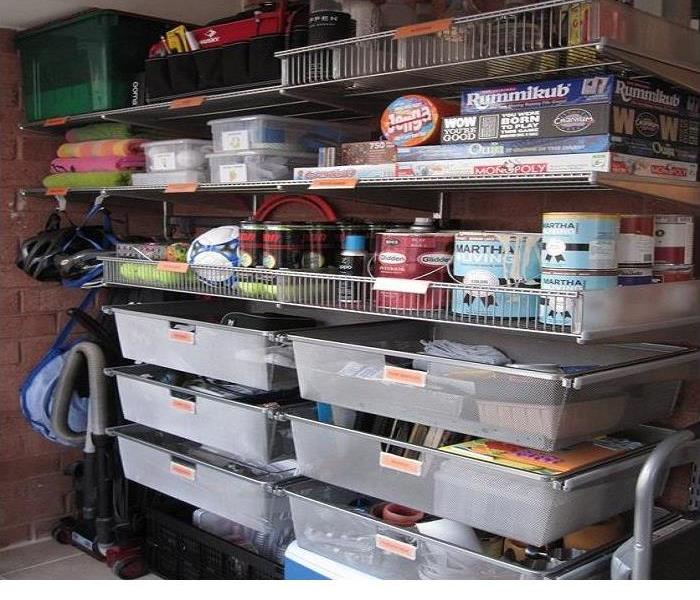 Keep your personal property safe
Keep your personal property safe
We all know that prevention is the best medicine, but floods can happen at any moment from any number of causes. By completing regularly scheduled home maintenance and keeping an eye out for common warning signs, you can minimize the chances of a flood. However, nothing can give you a 100% guarantee of never having a flood. In that case, preparation is the best way to minimize water damage.
First, it’s a good idea to know your flood risk. Are you in a potential flood zone? Is your yard sloped away from your foundation? Knowledge is power so the more you know about how your home might flood, the more steps you can take to prevent it or minimize damage from it.
Using waterproof building materials is a great way to reduce damage from flooding and there are waterproof sealants and paints that can be applied to existing structures. In particular, there are many protective coatings for block or poured concrete walls which are common in basements.
Keep your valuables and irreplaceable items such as photo albums, yearbooks, and important documents on high shelves. Do the same with chemicals and paints. If they leak into flood waters, they could cause additional damage. Any items put away for storage should be in air and water-tight plastic containers. Never leave boxes or items on the floor; instead, invest in raised shelving units.
It may also be a good idea to raise appliances and electronics off the ground. Get wires and power strips out from behind your tv stand and organize them in a way that keeps them out of the flood danger zone. Put washing machines and dryers on cinder blocks or sections of lumber to reduce the chances that rising water levels will affect them.
If a flood does strike, turn off electricity, gas, and water lines and place buckets under active leaks. If the water is pooling slowly, soak up as much of it as possible to reduce the potential damage. Calling SERVPRO at the first sign of a flood is the best way to reduce water damage. Our highly trained technicians will solve your immediate problems and ensure you don’t experience lasting effects or further damage.
Flooding can happen to anyone. Take steps now to protect your home and keepsakes from water damage in the event of a possible flood.





 24/7 Emergency Service
24/7 Emergency Service






















